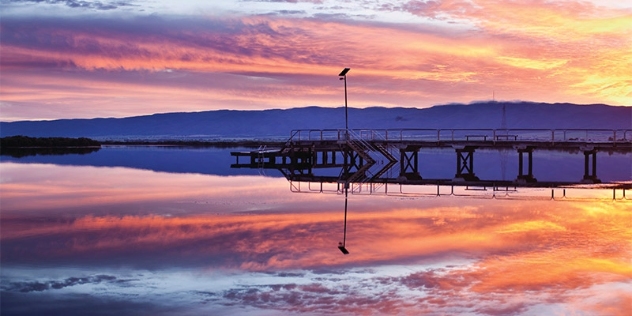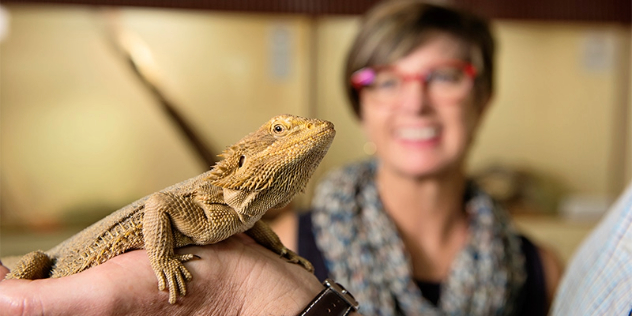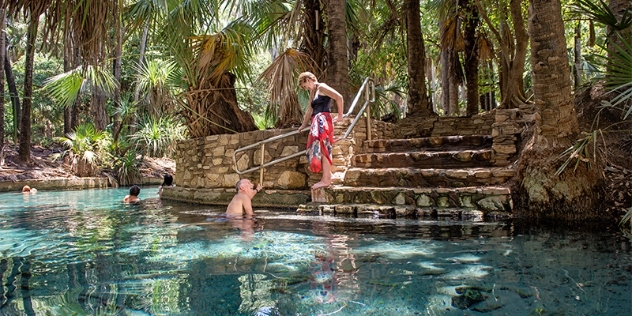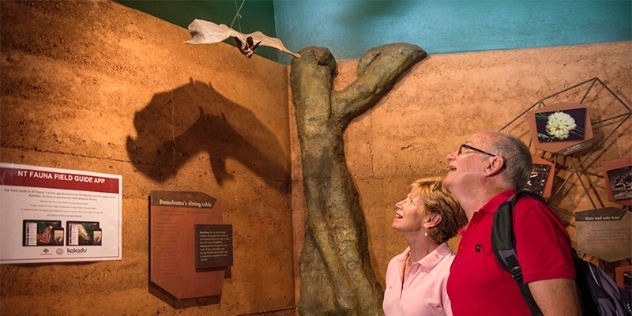Day 1: Adelaide to Pimba
Stop 1: Coffee, art and a shark at Port Pirie
Port Pirie (Photo credit: Port Pirie Regional Council)
Stop 2: Lunch in Port Augusta
Port Augusta has long been a popular gateway to the outback for tourists of all generations. It was even used as a film set for outback scenes in the 1959 film The Sundowners that starred Robert Mitchum, Deborah Kerr and Peter Ustinov. For a deeper history of the land that stretches back to the dreamtime visit the Australian Arid Lands Botanic Garden and Wadlata Outback Centre. The Yarta Purtli Port Augusta Cultural Centre is a buzzing hub for the town’s creative community and hosts the annual Desert Fringe festival in March. Eat at the café in the Botanic Garden, Archers Table by the river or The Office Café in town.
Stop 3: Stay at Pimba or Woomera
Cross the plains for 1.75 hours from Port August to the tiny but popular roadside town of Pimba. Sleep and eat at Spud Roadhouse, named after a local character who entertained guests until he passed away in 2007. The roadhouse serves as a refuelling point for tourist and freight vehicles, and offers cheap hotel rooms and caravan and camping sites. The tiny town sits at the crossroads of the Stuart Highway (named after the explorer) and Pimba Road, and its railway siding is a stop for the Ghan (to Darwin and Adelaide) and the Indian Pacific (to Perth and Sydney). If you get in well before dark, take a short 15-minute drive to visit the rocket museum and missile park at Woomera, or 55 minutes to the bustling mining town at Roxby Downs, built in the late 1980s.
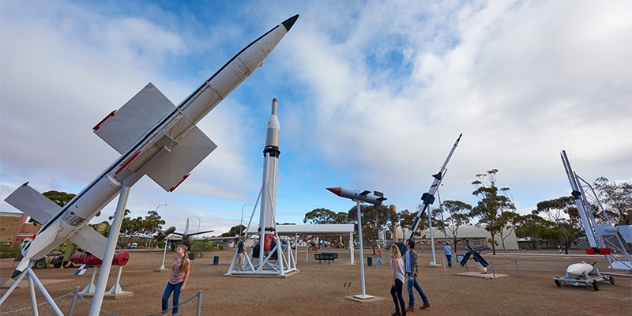
Woomera Missile Park (Photo credit: SATC)
Day 2: Pimba to Coober Pedy
3 HRS 38 MINS | 366 KMS
Stick to the Stuart Highway (there are restrictions on the Olympic Dam route) for a fast trip up to the Opal Capital.
Soon after you’ve left Pimba, you’ll pass the old salt beds of Lake Hart on your right, which might be worth a photo if the weather is right. Stop at Glendambo to double-check you have enough fuel, water and other supplies for the 288km drive north to Coober Pedy, as it’s the only roadhouse on the route.
Known as the Opal Capital of the World, thanks to its dominance of the gem-quality opal supply worldwide, Coober Pedy sits in the middle of a desert that heats up to 45 degrees Celsius in the shade during summer. Because it’s so hot outside, most buildings are below ground, with several metres of insulation to keep cool.
Start at the tourist centre to get the, well, lay of the land. Mine tours are popular with all ages, as is The Coober Pedy Art Project, which is run by Ananguku Arts and hosts more than 50 aboriginal painters from the region. There’s also a cute hybrid art gallery/wildlife refuge at Josephine’s Gallery and Kangaroo Orphanage.
Sleep and eat at the Lookout Cave for a wonderfully unique experience. The accommodation is underground, which celebrates the quintessential underground architecture while still offering the contemporary extras travellers seek. Alternatively, stay at the Mud Hut or Comfort Inn.
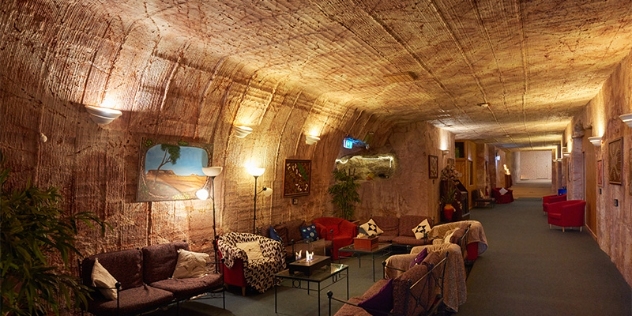
Comfort Inn Coober Pedy (Photo credit: SATC)
Day 3: Coober Pedy to Kulgera
4 HRS 14 MINS | 414 KMS
Get up early for the sunrise over the ‘Painted Desert’ and hit the road before it gets too hot.
Just 26 minutes north out of town and 9km from the highway, you’ll find the bizarre mesas at the Breakaways Conservation Park, which look like lunar hills that have broken away from the rest of the range. They have an ever better name in the local Aboriginal Antakarinya language: ‘Umoona’. It’s the name of a tree in the area that represents long life.
The earth will look redder as you approach Central Australia and the NT border. About 90 minutes before you cross into the Territory, stop for food, fuel and supplies at Marla Travellers’ Rest, which includes a large roadhouse with 24/7 dining, motel rooms, camping sites, a supermarket and a pool. If you’re feeling weary, you can ask if there are any rooms available and go for a refreshing swim.
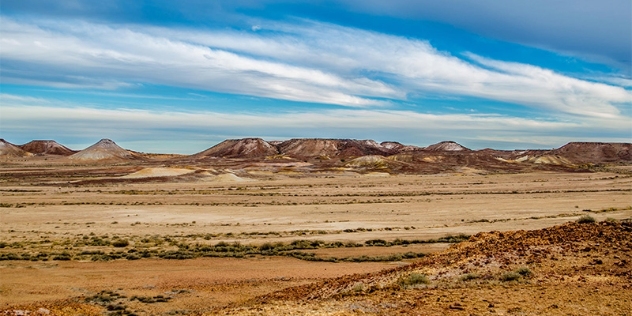
Breakaways Conservation Park (Photo credit: SATC)
Stop 3: Take a photo at SA/NT border
You won’t miss the border crossing from SA to NT because there’s a huge stone sign on the Stuart Highway to tell you. On the SA side it has a picture of Sturt Desert Peas, and on the NT side it has a brolga flying towards the sunset. May as well get pics of yourself wedged into the rock on both sides.
About 20km north of the NT border (and almost in the physical centre of our island), is a tiny town that gets its identity and name from the Pitjantjatjara people, who called the chunky granite ridge nearby ‘Kulgera’. Sleep and eat at Kulgera Roadhouse Hotel, which has a range of accommodation from backpacker dorms to campsites, cabins and hotel rooms, plus a proper country pub.
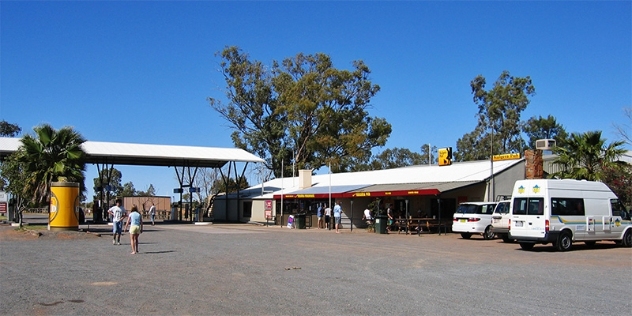
Kulgera Pub (Photo credit: qwesy qwesy)
Day 4: Kulgera to Uluru
4 HRS 8 MINS | 338 KMS
Grab coffee in Erldunda then go west a few hours to the greatest rock on Earth.
Stop 1: Enjoy morning tea in Erldunda
You could easily just head north to Alice Springs, and you’d be there in a couple more hours … but seeing as you’ve come this far into the middle of Australia, you’d kick yourself for not going west to Uluru. Sit down for morning tea (or coffee or a cold drink) at Erldunda Roadhouse, refuel if you need to and then head to Uluru.
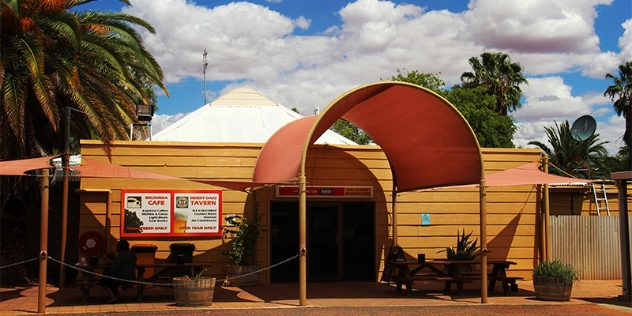
Erldunda Roadhouse (Photo credit: Sarena Hyland; Tourism NT)
Stop 2: See desert art at Mt Ebenezer
Mt Ebenezer is an art gallery and roadhouse run by the local Imanpa Community of Yakunytjatjara and Pitjantjatjara people about 50km from Erldunda. Visit during the week and you can meet aboriginal artists while they create paintings, jewellery and wood carvings.
Stop 3: Detour to Atila (Mt Conner)
There’s a long, flat-topped mesa nearly a kilometre long that juts out of the scrubland just off the Lasseter Highway. Named ‘Atila’ by the Yankunytjatjara people, it’s an important part of a west-to-east song line about Seven Sisters and Ice Man. The mesa is on private land, so unless you’ve booked a private tour at Curtin Springs Station, the best way to enjoy the view is from the main road.
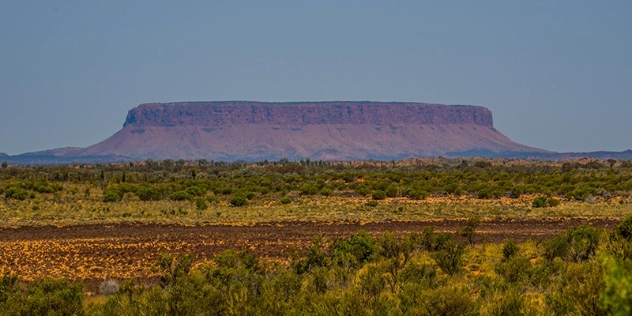
Mount Conner (Photo credit: Tauri Minogue; Tourism NT)
Of course, you’ll want to settle in before sunset so you can experience Uluru’s magical transformation. There are plenty of accommodation options, but book ahead – even for a camping ground – if you’re coming mid-year, because Uluru is, after all, iconic. Budget choices include Ayers Rock Campground, Outback Pioneer Lodge and Hotel at the Ayers Rock Resort, with access to BBQ facilities, tennis courts, swimming pools and a tour desk. At the edge of the resort site is the luxury Sails in the Desert hotel with five-star rooms, suites and its own gallery, spa, swimming pool and restaurant. Eat at one of the venues within the resort to have a classic three-course set menu at Ilkari Restaurant, pizzas, pastas, salads, burgers and steaks at Gecko’s Café, or modern Asian at the pun-tastic Ayers Wok Noodle Bar.
The final word in luxury at Uluru is the ‘tent resort’ of Longitude 131 on its own private site within Uluru-Kata Tjuta National Park. All of the tents face Uluru and if you treat yourself to a night or two here you’ll also have access to an open bar and complimentary scenic helicopter flight. The resort does not accommodate children under 10. Dine under the stars at Table 131 or beneath the soaring dome of Dune House – both venues offer fine dining with matching wines.
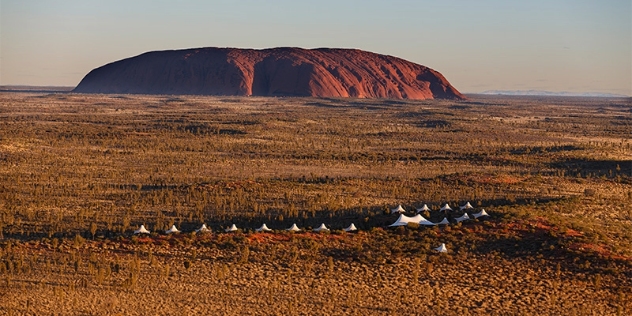
Longitude 131, Uluru (Photo credit: Peter Aitchinson; Tourism NT)
Day 5: Uluru and Kata Tjuta
41 MINS | 53 KMS
Stop 1: Watch the sunrise over Uluru or Kata Tjuta
It’s totally worth setting an early alarm (or wakeup call) to see the sun come up over Uluru or Kata Tjuta. If you’re staying at the Ayers Rock Resort, get onto a bus for the half-hour drive to Uluru Sunrise Viewing Area south-east of the rock inside the national park or, if you’re at Longitude 131, you’ll have a private view from your bed. Alternatively, enjoy a second breakfast half an hour west at the Kata Tjuta Viewing Area overlooking Kata Tjuta’s cupola-like rock formations and the Valley of the Winds.
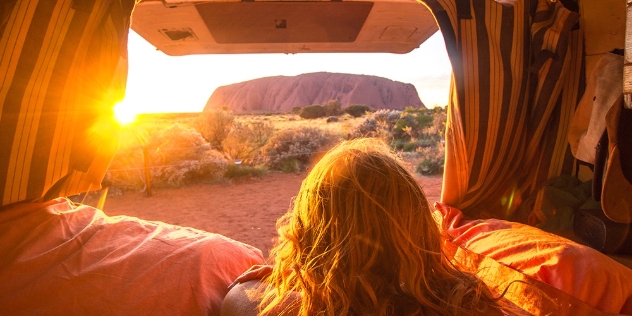
Uluru at sunrise (Photo credit: Mitchel Cox; Tourism NT)
Stop 2: See Aboriginal art
Visit the Culture Centre run by Parks Australia and learn about the land from its traditional owners. The Centre is also the starting point to discover more local dreamtime stories, art techniques and bush food on an Uluru Aboriginal Tour. The Maruku Arts gallery at the Centre features traditionally crafted tools, paintings and artefacts from Central Western Desert Anangu artists, while the Walkatjara Gallery supports artists from the local Mutitjulu community and gives space for Anangu artists to work.
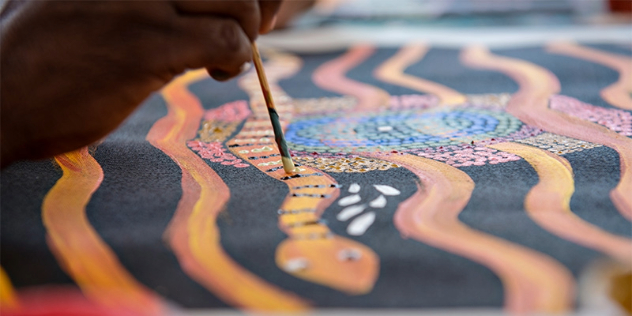
Maruka Arts Dot Paintings (Photo credit: Shaana McNaught; Tourism NT)
Stop 3: Stay a second night
See the sun set over Uluru or Kata Tjuta, then (if you’ve booked well ahead) take a tour of the solar powered Field of Light made up of 144 projectors and 50,000 little coloured spheres on stems covering a few square kilometres of desert like an electric dot painting near Uluru. Field of Light was created by Bruce Munro and will be on display until March 2018.
Day 6: Uluru to Watarrka/Kings Canyon
4 HRS 20 MINS | 319 KMS
A modest 4 hours 20 minutes’ drive to Watarrka National Park.
Stop 1: Stretch your legs in Curtin Springs
Curtin Springs is an hour east of Uluru. A family-run business, it includes a paper production plant, Wayside Inn, walking tours to the flat-top mesa of Atila (Mt Conner) and a huge million-acre cattle station.
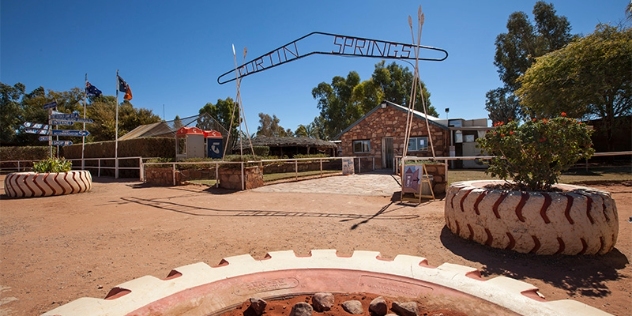
Curtin Springs Wayside Inn (Photo credit: Curtin Springs Station; Tourism NT)
Stop 2: Get to Kings Canyon before sunset
Whether you take a guided tour or make the shorter South Wall Return Walk, you’ll want to leave at least 3.5 hours to traverse the rim of the canyon before sunset. Both have views down into the Garden of Eden. A shorter Kings Creek Walk takes you into the middle of the canyon for an overwhelming view of the cliff face. Sunrise walks are equally amazing.
Sleep and eat at Kings Canyon Resort, which offers hotel rooms, cabins and campsites, plus a pool, playground, communal kitchen and general store. The Resort houses three dining venues: Carmichael’s Restaurant, with a breakfast buffet and evening banquet; Desert Oaks Bistro for light meals, snacks and picnics; and Under the Desert Moon for modern Australian cuisine outdoors. If you’d like a luxury farm stay and a home-cooked camel burger, hire a safari cabin or glamping tent at Kings Creek Station.
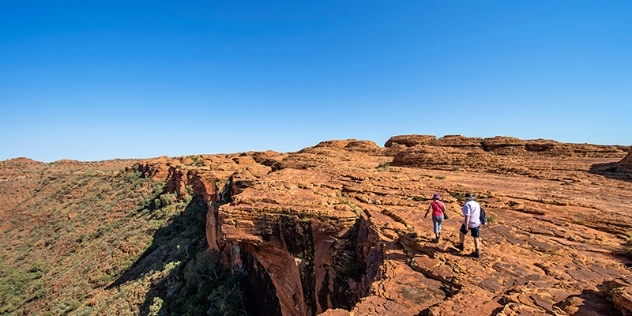
Rim Walk, Kings Canyon (Photo credit: Shaana McNaught; Tourism NT)
Day 7: Watarrka/Kings Canyon to Alice Springs
6 HRS 4 MINS | 473 KMS
A full day’s drive as you retrace some of your journey along National Highway 87 and Luritja Rd/State Route 3 (don’t take Route 6 north, it’s three hours longer on a very slow track).
Erldunda Roadhouse sits 260kms from Uluru and 200kms from Alice Springs at the intersection of the Lasseter (west-east) and Stuart (south-north) Highways. There’s a big dining area inside and some native animals living in paddocks outside, including kangaroos, emus and the non-native, but internationally-famous, Cluck Norris rooster who hangs out with the 'roos.
Stop 2: Stretch your legs at Finke River
About a third of the way between Erlunda and Alice Springs, you’ll probably see a decent gathering of grey nomads with their camper trailers and motorhomes. This is the Finke River rest stop and it’s especially popular in winter. The river itself rarely flows.
Stuarts Well Roadhouse is a launching station for off-the-track adventures to the natural beauties of the sandstone Chambers Pillar, Henbury Meteorites field and Rainbow Valley. It’s also a popular place to get coffee, snacks and full meals – and was once the home of Dinky the Singing Dingo.
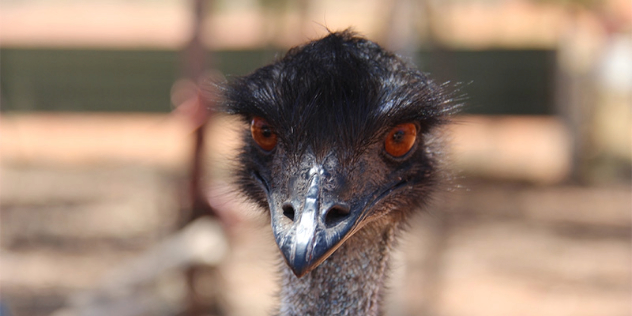
Stuarts Well (Photo credit: Sarena Hyland; Tourism NT)
Stop 4: Stay at Alice Springs
Wrapped in the stunning Aranda or MacDonnell Ranges, Alice Springs is a bustling town in the middle of the Red Centre with thriving arts and sports scenes. The infamous Henley-on-Todd Regatta is a bizarre series of races in bottomless boats along the dry bed of the Todd River held on the third Saturday of August.
Explore the story of the man on the Australian $20 note via the Flynn Trail, which takes in historic sites such as the John Flynn Memorial Church, Adelaide House Museum and the Royal Flying Doctor Service (the first of its kind in the world when built in 1926).
Good value accommodation is available at Desert Palms which offers studio villas. If you're looking for luxury, options include the Crown Plaza Lasseters Hotel Casino and Hilton Double Tree Hotel Alice Springs.
Eat at your hotel or head out for a light meal at Watertank café, Bean Tree Café or Page 27. Lasseters recently opened The Goat and Bucket, serving up gourmet fare based on natural local flavours plus craft beer and wines.
Day 8: Alice Springs
Take a day to rest and/or see more of the town.
Stop 1: Explore the history and natural wonders of The Alice
Alice Springs Reptile Centre (Photo credit: Shaana McNaught; Tourism NT)
Stop 2: Side trip to Standley Chasm
Take a 90-minute roundtrip to the Aboriginal-owned Standley Chasm nature reserve, which really shines when the sun is getting high around midday. A fairly easy 20-minute walk will take you into the gully home of myriad bird species. There's also a popular kiosk where you can get lunch or buy BBQ supplies.
Stop 3: Ellery Creek Big Hole
A two-and-a-half-hour round trip further into the West MacDonnell Ranges will get you to the spectacular (and cooling) Udepata or Ellery Creek Big Hole which is encircled by massive, sheer red cliffs. BBQ and picnic facilities are open all year round, so bring lunch.
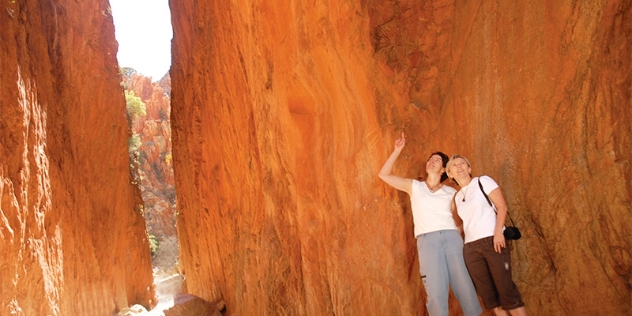
West Macdonnell Ranges (Photo credit: Mark Varvelis; Tourism NT)
Day 9: Alice Springs to Tennant Creek
5 HRS 47 MINS | 508 KMS
Soak in the beauty of the Centre on a steady drive north.
Stop 1: Art and lunch in Ti Tree
Halfway to Tennant Creek from The Alice is the small town of Ti Tree. It’s a meeting and trading point for six surrounding Aboriginal settlements including Utopia, home of the Papunya aboriginal art movement that put desert art on the world stage and a new art scene that began in the late 1980s mostly using acrylic on canvas. It’s now also a profitable table grape and melon growing region thanks to plentiful sunshine and fresh underground water. After visiting some stores to check out local art, stop to eat and refuel at Ti Tree Roadhouse, the most central pub in Australia.
Stop 2: Central Mount Stuart
In 1860 the explorer John McDouall Stuart carried a British flag up this chunky hill about 18km north of Ti Tree on his long trek to Darwin. No one can find the pile of stones he’s meant to have planted the colours in, though there’s a plaque at the bottom noting he originally called it Sturt. Admire it from the base (the climb is rough).
Stop 3: Karlu Karlu (Devils Marbles)
The local Warmungu people have a beautiful story about the collection of gigantic granite boulders an hour south of Tennant Creek: Karlu Karlu (or Devils Marbles) are ancient fossilised eggs of the Rainbow Serpent from dreamtime. As the egg rocks are still evolving with the weather, some of them look like they could hatch a baby Rainbow Serpent any day now…
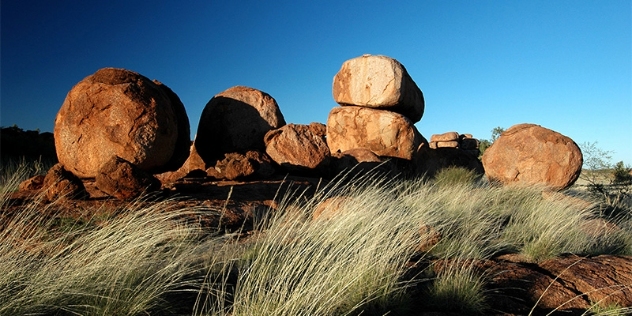
Devils Marbles Conservation Reserve (Photo credit: Sam Tinson; Tourism NT)
Stop 4: Go off track at Iytwelepenty/Davenport Range National Park
If you have a 4WD (or book a tour) and a day or two for off-the-beaten track adventure, make time to access the Iytwelepenty/Davenport Range National Park via Kurundi Station south of Tennant Creek. It’s a popular destination for waterbirds, black-footed rock wallabies and bush turkeys. There are campsites at Old Police Station Waterhold and Whistelduck Creek.
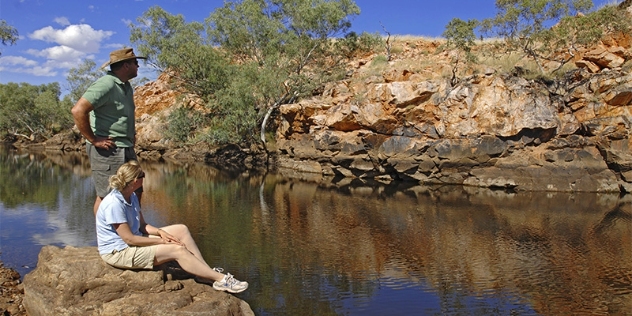
Whistle Duck Creek, Davenport Ranges (Photo credit: Steve Strike; Tourism NT)
In the dreamtime, this area was the stomping ground of a spiky tailed goanna called Nyinkka. You can learn more about the legend from the Warumungu people at the Nyinkka Nyunyu Art and Culture Centre, which includes a gallery, shop and performance spaces owned and managed by local Aboriginal people.
Kunjarra (The Pebbles) is a sacred site for women in the middle of hundreds of beautiful granite rock formations about a 40-minute roundtrip north from town. The Winanjjikari Music Centre is a popular concert venue, recording studio and music industry skills development centre for Aboriginal musos and production technicians – check the notice board for info about gigs in town tonight.
In the late-1800s, Tennant Creek became a small outpost on the Overland Telegraph line from Melbourne to London then it metamorphosed during Australia’s last proper gold rush in the 1930s. You can see how mining methods evolved over the years on a tour at the Battery Hill Mining Centre and nearby Tuxworth-Fullwood Museum.
Places to sleep include the pet-friendly Blue Stone Motor Inn, which has a large outdoor pool and popular Anne’s restaurant and Goldfields Hotel Motel which offers value accommodation in a central location for those on a budget. Try the Top of Town Café for breakfast.
Day 10: Tennant Creek to Daly Waters
4 HRS 26 MINS | 399 KMS
Stop 1: Detour to Barkly Homestead
Two-and-a-half hours east of Tennant Creek along Route 66 is Barkly Homestead, with its Bar & Grill, powered camping sites and motel. It’s also a popular place for small plane tourists who want to see the outback from above thanks to its aviation refuelling station.
Stop 2: Enjoy a picnic at Lake Woods
Pack a picnic before leaving Tennant Creek then drive a couple hundred kms north to the wetlands of Lake Woods. Pelicans, white egrets and spoonbills love to fish here, while Rainbow Bee Eaters flit about the trees avoiding the birds of prey above. It’s especially brilliant if you bring binoculars.
Stop 3: Go for a walk in Elliot
Drop into Elliot Store for some afternoon snacks before strolling through Jim Rennie Memorial Park for its aboriginal story walk. There’s also a nine-hole golf course in town.
Stop 4: Stay in Daly Waters
The tiny town of Daly Waters has a colourful connection with aviation history in the first half of the twentieth century. In 1926, it was an important stop in the London to Sydney air race and a refuelling station for Qantas flights to Singapore until 1965. The Daly Waters WWII Historic Airstrip was also a resting point for fighter planes being flown to Darwin via Cloncurry in World War II. Several USAAF and RAAF planes crashed nearby during training and other manoeuvres.
Refuel and rest here before driving to Katherine. Sleep and eat at the Daly Waters Hi-Way Inn, which offers motel rooms, cabins, camping sites, BBQ area, restaurant, bar and a swimming pool. Or you could enjoy a night out at the historic Daly Waters Pub, which has motel rooms, cabins, camping sites, caravans and a pool plus a kooky display of ‘memorabilia’ donated by travellers from near and far including an Irish Hurling stick and hundreds of bras.
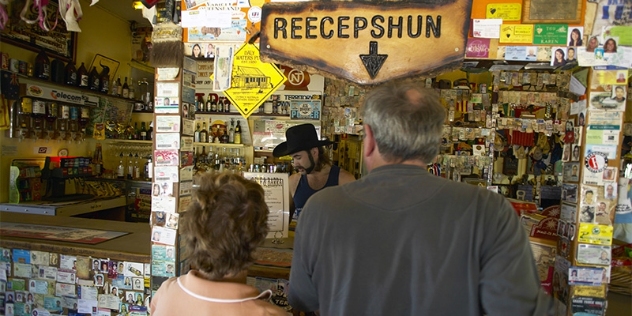
Daly Waters Pub (Photo credit: Peter Eve)
Day 11: Daly Waters to Katherine or Nitmiluk
3 HRS 7 MINS | 276 KMS
Easy morning’s drive along Highway 1 via beautiful thermal springs.
Stop 1: Elsey National Park and Mataranka
Mataranka Thermal Springs, Elsey National Park (Photo credit: Shaana McNaught; Tourism NT)
Stop 2: Stay in Katherine or Nitmiluk Gorge
Katherine and Nitmiluk Gorge are colloquially known as ‘Adventure Territory’, with stunning natural attractions including Katherine’s Hot Springs, Katherine Low Level Nature Reserve and Nitmiluk Gorge. Discover the history and art of the region at Katherine Museum and Godinymayin Yijard Rivers Art and Cultural Centre – the latter includes regular cultural performances, exhibitions and workshops celebrating the Yijard Rivers stories.
If you want to stay in town, budget accommodation includes hotel rooms at Ibis Styles Katherine, which is located centrally, or Katherine River Lodge Motel, which has a range of rooms including a family unit.
Out of town there are caravans, camping sites, cabins and chalets, a luxury eco-resort at Cicada Lodge Nitmiluk National Park with local aboriginal art in each room and fine dining, and the Djakanimba Pavilions near the Ghunmarn Culture Centre at Beswick, 100km out of Katherine. Eat on site wherever you stay or try waffles and jaffles from The Black Russian Caravan Bar or bush tucker at Marksie's Stockman's Camp Tucker Night at the Top Didj Cultural Experience grounds.
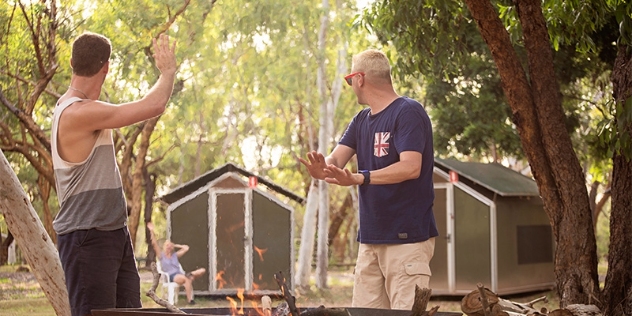
Campground at Nitmiluk Gorge (Photo credit: Shaana McNaught; Tourism NT)
Day 12: Katherine to Kakadu
1 HR 40 MINS | 152 KMS
An incredible journey into the World Heritage listed Kakadu National Park.
Bowali Visitors Centre (Photo credit: Shaana McNaught; Tourism NT)
Day 13: Kakadu to Litchfield National Park
2 HRS 2 MINS | 199 KMS
A few hours’ drive west to the waterfalls and pools of Litchfield National Park.
Stop 1: Explore Litchfield National Park
Litchfield National Park is close enough to Darwin for a day trip to some parts, though you’ll enjoy it more if you can stay overnight – even better if you have a 4WD so you can explore off-the-track sites such as Blyth Homestead, Rum Jungle Lake and Bamboo Creek Mine. Many of the popular swimming spots are accessible in a standard vehicle though make sure you have enough fuel, water and food. Check the safety signs about crocodiles and road closures, especially during the wet season.
Visit Batchelor’s Coomalie Cultural Centre for aboriginal art exhibitions, bush tucker garden and educational tours. Sleep and eat at Pandanus on Litchfield, which offers a range of rooms including those suitable for families. Barbecue facilities are available, alongside a restaurant and outdoor pool. All rooms at the Litchfield Motel overlook the Motels gardens for a relaxed setting. A restaurant and small shop are also on site so you have everything you need. Alternatively, Rum Jungle Bungalows is conveniently located on one acre of quiet and idyllic tropical gardens. There are just six detached bungalows on site, all with their own private verandah.
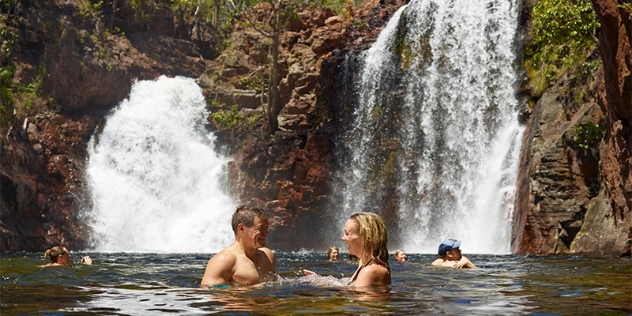
Florence Falls, Litchfield National Park (Photo credit: Peter Eve; Tourism NT)
Day 14: Litchfield National Park to Darwin
1 HRS 20 MINS | 116 KMS
Head to our Top End city in an hour or so, maybe stopping to see some crocs on the way.
Stop 1: Adelaide River, Mary River and Darwin
Locals are more wary than awed by the deadly and ancient apex predators of the Top End, though there’s something crazy and cool about seeing a crocodile go ballistic for food. Adelaide River is the only local waterway where it’s actually legal (for licensed tour companies) to feed the crocodiles. It’s quite an adrenalin rush on a river cruise when the crocodiles jump out of the water to chomp on food dangled several metres above water.
Book a seat on a croc boat with Spectacular Jumping Crocodile Cruise or Adelaide River Cruises on the Adelaide River. Wetland Cruises runs tours of the Corroboree Billabong in the Mary River Wetlands where you can see saltwater crocodiles going about their day-to-day business. In the city you can get underwater views – and even float inside a ‘Cage of Death’ up close to the crocs – at Crocosaurus Cove. There’s also the preserved body of a massive salty croc called Sweetheart (a male croc, named after the waterway he terrorised) at the Museum and Art Gallery of the Northern Territory.
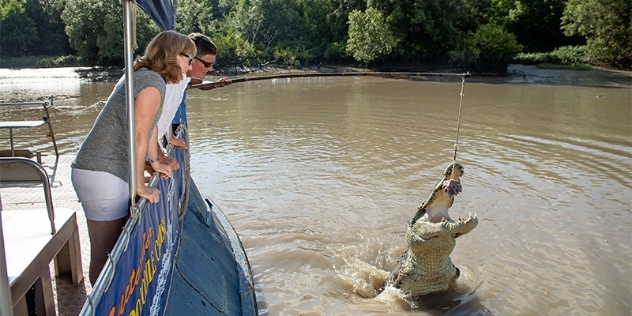
Spectacular Jumping Crocodile Cruise (Photo credit: Shaana McNaught; Tourism NT)
Darwin is sometimes remembered more for its tough times, including the World War II bombings, which are presented in spectacular and moving interactive displays at the Darwin Military Museum, and Cyclone Tracy, detailed at the Museum and Art Gallery of the Northern Territory. There are plenty of beautiful cultural experiences to enjoy in and around the city, like an Aboriginal cultural tours with Pudakul, which shares tens of thousands of years of history, including lessons on bush tucker and medicine, spear and basket making, ochre art, clap stick and didgeridoo music and dreamtime stories. The Territory Wildlife Park includes native animal and bird adventures through tree top aviaries and around natural lagoons. On Thursday and Sunday evenings eat and shop at Mindil Beach Sunset Market, with a heady mix of international cuisine, buskers, artists and fashion designers. Drink in the dreamy sunset at Casuarina Coastal Reserve, Dudley Point, Fannie Bay Mindil Beach or Stokes Hill Wharf.
For great views and luxury rooms book at Adina Apartment Hotel Darwin, Travelodge Resort Darwin, Vibe Hotel Darwin Waterfront.
Enjoy brunch and a coffee to kick-start your day at Laneway Specialty Coffee located on Vickers Street. Or lunch at the popular Vietnamese restaurant Ruby Pho and head for dinner on the wharf at the Oyster Bar, conveniently located in the Darwin City Waterfront Precinct. They serve up fresh oysters all year round and sharing platters to enjoy.
